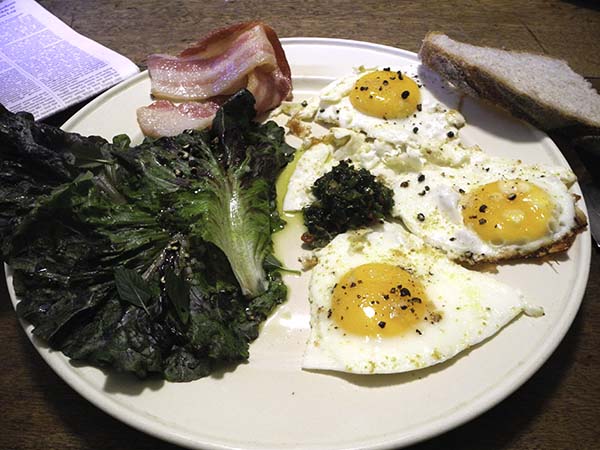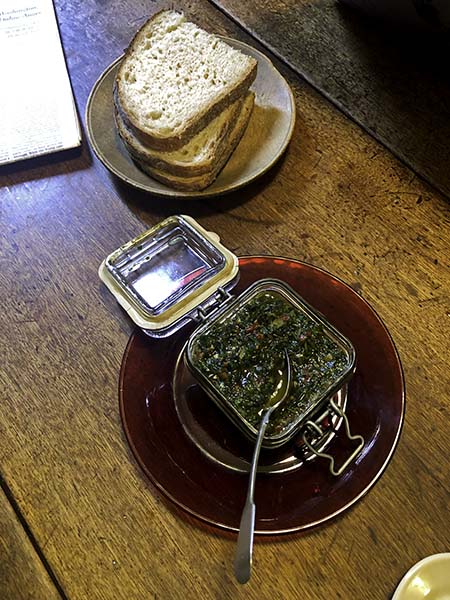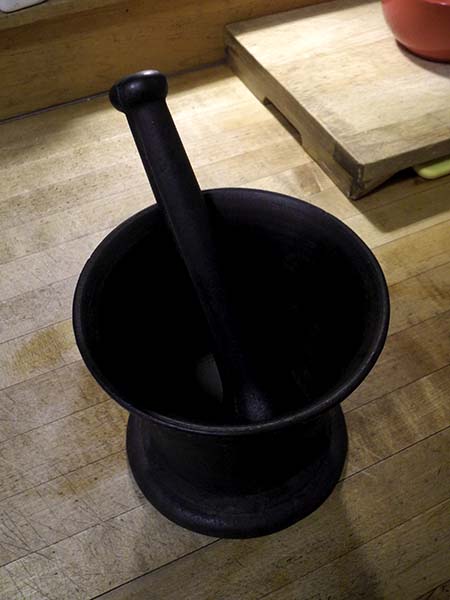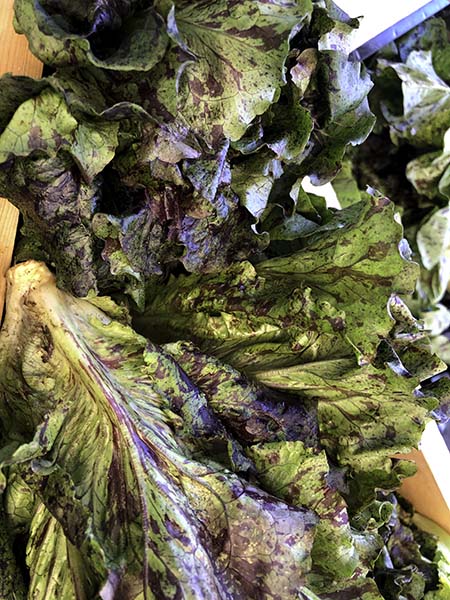
‘Morgenblätter‘.
As someone keen on both journalism and food, I often think of that beautiful 19th century waltz at breakfast time, especially on Sundays. I don’t actually hum it, but I enjoy all the pleasant associations of the word, with the usual exception of the contents of the news itself.
Well, it wasn’t our usual morning papers-with-[b̶r̶e̶a̶k̶f̶a̶s̶t̶]-lunch Sunday: This one was attended by some Zhug.
As the citizen of a great European imperial capitol whose territories extended into the Balkans and nearly all the way to the Black Sea, Johann Strauss Jr. was able to know and appreciate more dishes than those we think of as belonging to German cuisine, but he may never have had Zhug.
I first found out about it last week.
Maybe it’s just me, and my basically Eurocentric kitchen orientation (which is driven by time and space considerations more than any immovable preference), but most of the time I find I can ignore the recipe pages of the New York Times Magazine. It seems like the editors’ choices are mostly about courting points, wherever, for their eccentricity or sensationalism, sometimes with a side trip to silly. Also for the parties.
The recipe featured this past week was an exception. The subject was Zhug, a rich green sauce from Yemen, and it included a recipe with a loving description of the somewhat laborious process involved in making it.
I don’t know what it was that kept me lingering on the pages of the article this time. It may have been the photograph that showed a rich sauce getting friendly with, among other delicacies, a simple fried egg (Barry and I both love fried eggs). In any event, when I remembered Sunday was almost upon us, and once I realized I already had or could quickly gather together all of the ingredients (note: they aren’t really exotic at all), I was on my way.
But that would be only after a quick stop to search on line whether the sauce could be stored for any length of time, since it didn’t seem worth the trouble to make some if it wasn’t to be in the quantity described by the recipe: The answer was a definite yes, and one account, spotted on Serious Eats, was pretty specific: “It should last a few weeks in the fridge (though I’ve never had a jar linger long enough to actually find out)”.
Another reason for my interest in the recipe: I can spend a lot of time (and go through a lot of little bowls) assembling a lot of condiments for our traditional Sunday bacon and eggs early afternoon meals, and I thought this rich spicy sauce could be an interesting, if probably only occasional, alternative, and a big time saver too (as if that should ever be an operating principal for such meals).

The bottom line: The sauce is pretty complex, and really delicious, and a little goes a long way. It’s also really beautiful, if you’ve managed to include some red peppers. It would be a significant addition, more than just an accent, and just very comfortable with virtually any kind or form of Mediterranean dish. The world surrounding the Mediterranean on all side is one whose cultures were birthed in the civilizations of the Middle East, and Yemen’s is one of the richest of those. It’s that Mediterranean that describes much of the eating preferences of Barry and myself.
In my own cooking I’ve hosted more extreme deviations from the European kitchen than that represented by this sauce, and increasingly so as the years go by and I become more comfortable in my skills and my tastes, but also as our local suppliers introduce us to more and more interesting alternatives to traditional European preparations.
Did I mention that I tweaked the recipe published in the Times, even on this, my first outing? It was mostly about playing with the kinds of chilis used, because of what I had on hand, because I wanted color, and because I was looking for as much complexity of flavor as possible. Also, I didn’t have the amounts of parsley and cilantro prescribed (so much!); I used only about half the volume, but some of my mix of chilis had no heat at all, so it may have evened out in the end.
Is it European?
Gabrielle Hamilton, the author of the article in which the Zhug recipe appears, and the chef/owner of New York’s Prune restaurant, includes this paragraph in her introduction:
For the entirety of Prune’s 20 years, I’ve confined myself — with pretty strict discipline — to cooking within a European-and-Mediterranean idiom. It has been two decades of salsa verde, gremolata, sauce gribiche and maître d’hôtel butter, with all the rest doused in olive oil. Of course, giving yourself the entire European-and-Mediterranean pantry is hardly a confinement. Somehow it has never even proved to be a monotony. It has just been a nonnegotiable outline of territory on a map, so that we all know how far we can go and what we are meant to be doing as we cook menu after menu after menu, season after season, six new menus a year, 20 solid years in a row. And that’s not counting desserts.
I think this is a fair evaluation of the material many Western cooks have to work with, although we are now blessed with farmers and fishers and bakers who encourage us to expand our comfort zones. Interestingly, in her next paragraph Hamilton goes on to add that, away from the restaurant, when cooking at home, she works with no such constraints.
Sigh. With more space, and more skill, and more self-confidence, I can imagine going there too.

One thing I am proud to say about my excursion into Yemen is that I prepared my Zhug entirely by hand, working with a wonderful antique vessel, an almost 12-pound, 6″ x 6″ cast iron mortar and its original pestle, with no discernible maker’s mark, that I had long ago spent a week rescuing from its mid-career role, which was probably that of performing inside a machine shop.

- there were 6 fresh eggs from pastured chickens and 4 slices of bacon from pastured pigs, all from Pennsylvania’s Millport Dairy Farm in the Union Square Greenmarket, the eggs, while they were being fried, seasoned with a local Long Island sea salt (P.E. & D.D. Seafood/Phil Karlin’s own), freshly ground black pepper, a pinch of dried fenugreek from Bombay Emerald Chutney Company (purchased at the Saturday Chelsea Farmers Market), and accompanied by a dollop of Zhug, for which I had followed the recipe, and as I recall, virtually to the letter, with the exception of the makeup of the capsicum element (I used 4 kinds of peppers), and the addition of a few tablespoons of lemon juice stirred in at the very end; the sources of the fresh ingredients were: 6 cloves of ‘Chesnok Red’ garlic from Alewife Farm; 2 jalapeño peppers, one red, one green, from Alex’s Tomato Farm in the Saturday Chelsea’s Down to Earth Farmers Market; 1 habanada pepper from Campo Rosso Farm; 2 tiny Brazil wax peppers (very hot) and 2 aji dulce peppers (no real heat), both from Eckerton Hill Farm; fresh parsley and coriander from Jersey Farm Produce Inc. in the Saturday 23rd Street farmers market; several tablespoons of juice of a Mexican lemon from the Chelsea Gristedes Supermarket; leaves from a head of a mini speckled romaine lettuce from Quarton Farm. dressed with good Cretan olive oil, Renieris Estate ‘Divina’ (Koroneiki varietal), Hania, Crete, from Whole Foods Market, salt, and pepper, and some torn leaves from a branch of peppermint from Keith’s Farm; everything accompanied by slices (some toasted, some not) from a quarter of a 6-pound loaf of Orwashers Levin Locale (locally grown and milled wheat, 100% natural fermentation, durum flour, wheat bran, biga, malt), also from the Saturday Chelsea Market
- the Sunday music was Messiaen’s ‘Vingt regards sur l’enfant Jésus‘, performed by Joanna MacGregor